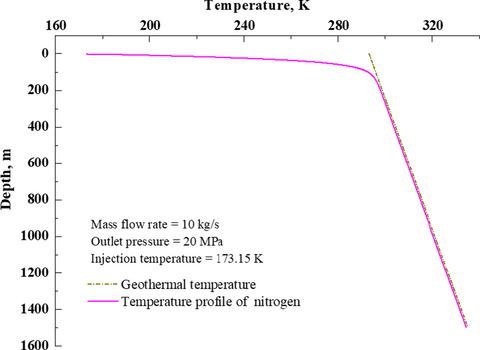当前位置:
X-MOL 学术
›
Energy Sci. Eng.
›
论文详情
Our official English website, www.x-mol.net, welcomes your feedback! (Note: you will need to create a separate account there.)
Predicting the radial heat transfer in the wellbore of cryogenic nitrogen fracturing: Insights into stimulating underground reservoir
Energy Science & Engineering ( IF 3.8 ) Pub Date : 2020-01-22 , DOI: 10.1002/ese3.479 Weiqiang Song 1, 2, 3 , Xian Shi 2 , Chunguang Wang 1, 3 , Jianchun Xu 2 , Shaojie Chen 1, 3 , Zhongwei Chen 1, 4
Energy Science & Engineering ( IF 3.8 ) Pub Date : 2020-01-22 , DOI: 10.1002/ese3.479 Weiqiang Song 1, 2, 3 , Xian Shi 2 , Chunguang Wang 1, 3 , Jianchun Xu 2 , Shaojie Chen 1, 3 , Zhongwei Chen 1, 4
Affiliation

|
Cryogenic nitrogen fracturing is an attractive method for stimulating underground reservoir, since it could favorably induce complex fracture due to the huge temperature difference with lower injection pressure and with the replacement of current water‐based fracturing fluid. However, the concern about whether cryogenic nitrogen would be overheated remains unrevealed in the engineering environment with large wellbore length. In addition, reservoir stimulation results are also related with the pressure state at bottom hole. Therefore, in this study, a mathematical model was proposed to predict the radial heat transfer and its influence on vertical pressure transmission in the wellbore with cryogenic nitrogen as fracturing fluid. The model fully couples the heat transfer, hydraulics, and the compressibility of nitrogen, and then, the calculation results were presented and analyzed through a case study. According to the results, the temperature of nitrogen increases too fast under conventional engineering conditions, and it changes into gaseous state at the depth lower than 100 m. Finally, the temperature difference between nitrogen and formation rock becomes too minimal to induce thermal stress at bottom hole. Due to the fast temperature increase, the density of nitrogen decreases too much, and the vertical pressure increasing rate by liquid nitrogen (1.66 MPa/km) is merely 18.2% that in carbon dioxide fracturing (9.13 MPa/km). The results indicate that utilization of special casing with much larger thermal resistance is an indispensable approach to realize the feasibility and advantages of cryogenic nitrogen fracturing.
中文翻译:

预测低温氮压裂井眼中的径向传热:增产地下油藏的见解
低温氮压裂法是刺激地下储层的一种有吸引力的方法,因为由于温差大,注入压力低以及替换了目前的水基压裂液,它可以有利地诱发复杂的压裂。但是,在井眼长度较大的工程环境中,对于低温氮气是否会过热的担忧仍然没有得到解决。另外,储层增产效果还与井底压力状态有关。因此,在这项研究中,提出了一个数学模型来预测以低温氮气作为压裂液的径向传热及其对井筒中垂直压力传递的影响。该模型将传热,水力和氮气的可压缩性完全结合在一起,然后,计算结果通过案例研究进行了介绍和分析。根据结果,在常规工程条件下,氮的温度升高过快,在低于100 m的深度处变为气态。最后,氮气和地层岩石之间的温差变得太小而无法在井底产生热应力。由于温度的快速升高,氮的密度降低太多,液氮在垂直方向的压力增加率(1.66 MPa / km)仅为二氧化碳压裂(9.13 MPa / km)的18.2%。结果表明,利用具有大得多的热阻的特殊套管是实现低温氮压裂的可行性和优点的必不可少的方法。根据结果,在常规工程条件下,氮的温度升高过快,在低于100 m的深度处变为气态。最后,氮气和地层岩石之间的温差变得太小而无法在井底产生热应力。由于温度的快速升高,氮的密度降低太多,液氮在垂直方向的压力增加率(1.66 MPa / km)仅为二氧化碳压裂(9.13 MPa / km)的18.2%。结果表明,利用具有大得多的热阻的特殊套管是实现低温氮压裂的可行性和优点的必不可少的方法。根据结果,在常规工程条件下,氮的温度升高过快,在低于100 m的深度处变为气态。最后,氮气和地层岩石之间的温差变得太小而无法在井底产生热应力。由于温度的快速升高,氮的密度降低太多,液氮在垂直方向的压力增加率(1.66 MPa / km)仅为二氧化碳压裂(9.13 MPa / km)的18.2%。结果表明,利用具有大得多的热阻的特殊套管是实现低温氮压裂的可行性和优点的必不可少的方法。深度小于100 m时变为气态。最后,氮气和地层岩石之间的温差变得太小而无法在井底产生热应力。由于温度的快速升高,氮的密度降低太多,液氮在垂直方向的压力增加率(1.66 MPa / km)仅为二氧化碳压裂(9.13 MPa / km)的18.2%。结果表明,利用具有大得多的热阻的特殊套管是实现低温氮压裂的可行性和优点的必不可少的方法。深度小于100 m时变为气态。最后,氮气和地层岩石之间的温差变得太小而无法在井底产生热应力。由于温度的快速升高,氮的密度降低太多,液氮在垂直方向的压力增加率(1.66 MPa / km)仅为二氧化碳压裂(9.13 MPa / km)的18.2%。结果表明,利用具有大得多的热阻的特殊套管是实现低温氮压裂的可行性和优点的必不可少的方法。氮的密度降低太多,液氮在垂直方向的压力增加率(1.66 MPa / km)仅为二氧化碳压裂(9.13 MPa / km)的18.2%。结果表明,利用具有大得多的热阻的特殊套管是实现低温氮压裂的可行性和优点的必不可少的方法。氮的密度降低太多,液氮在垂直方向的压力增加率(1.66 MPa / km)仅为二氧化碳压裂(9.13 MPa / km)的18.2%。结果表明,利用具有大得多的热阻的特殊套管是实现低温氮压裂的可行性和优点的必不可少的方法。
更新日期:2020-01-22
中文翻译:

预测低温氮压裂井眼中的径向传热:增产地下油藏的见解
低温氮压裂法是刺激地下储层的一种有吸引力的方法,因为由于温差大,注入压力低以及替换了目前的水基压裂液,它可以有利地诱发复杂的压裂。但是,在井眼长度较大的工程环境中,对于低温氮气是否会过热的担忧仍然没有得到解决。另外,储层增产效果还与井底压力状态有关。因此,在这项研究中,提出了一个数学模型来预测以低温氮气作为压裂液的径向传热及其对井筒中垂直压力传递的影响。该模型将传热,水力和氮气的可压缩性完全结合在一起,然后,计算结果通过案例研究进行了介绍和分析。根据结果,在常规工程条件下,氮的温度升高过快,在低于100 m的深度处变为气态。最后,氮气和地层岩石之间的温差变得太小而无法在井底产生热应力。由于温度的快速升高,氮的密度降低太多,液氮在垂直方向的压力增加率(1.66 MPa / km)仅为二氧化碳压裂(9.13 MPa / km)的18.2%。结果表明,利用具有大得多的热阻的特殊套管是实现低温氮压裂的可行性和优点的必不可少的方法。根据结果,在常规工程条件下,氮的温度升高过快,在低于100 m的深度处变为气态。最后,氮气和地层岩石之间的温差变得太小而无法在井底产生热应力。由于温度的快速升高,氮的密度降低太多,液氮在垂直方向的压力增加率(1.66 MPa / km)仅为二氧化碳压裂(9.13 MPa / km)的18.2%。结果表明,利用具有大得多的热阻的特殊套管是实现低温氮压裂的可行性和优点的必不可少的方法。根据结果,在常规工程条件下,氮的温度升高过快,在低于100 m的深度处变为气态。最后,氮气和地层岩石之间的温差变得太小而无法在井底产生热应力。由于温度的快速升高,氮的密度降低太多,液氮在垂直方向的压力增加率(1.66 MPa / km)仅为二氧化碳压裂(9.13 MPa / km)的18.2%。结果表明,利用具有大得多的热阻的特殊套管是实现低温氮压裂的可行性和优点的必不可少的方法。深度小于100 m时变为气态。最后,氮气和地层岩石之间的温差变得太小而无法在井底产生热应力。由于温度的快速升高,氮的密度降低太多,液氮在垂直方向的压力增加率(1.66 MPa / km)仅为二氧化碳压裂(9.13 MPa / km)的18.2%。结果表明,利用具有大得多的热阻的特殊套管是实现低温氮压裂的可行性和优点的必不可少的方法。深度小于100 m时变为气态。最后,氮气和地层岩石之间的温差变得太小而无法在井底产生热应力。由于温度的快速升高,氮的密度降低太多,液氮在垂直方向的压力增加率(1.66 MPa / km)仅为二氧化碳压裂(9.13 MPa / km)的18.2%。结果表明,利用具有大得多的热阻的特殊套管是实现低温氮压裂的可行性和优点的必不可少的方法。氮的密度降低太多,液氮在垂直方向的压力增加率(1.66 MPa / km)仅为二氧化碳压裂(9.13 MPa / km)的18.2%。结果表明,利用具有大得多的热阻的特殊套管是实现低温氮压裂的可行性和优点的必不可少的方法。氮的密度降低太多,液氮在垂直方向的压力增加率(1.66 MPa / km)仅为二氧化碳压裂(9.13 MPa / km)的18.2%。结果表明,利用具有大得多的热阻的特殊套管是实现低温氮压裂的可行性和优点的必不可少的方法。



























 京公网安备 11010802027423号
京公网安备 11010802027423号